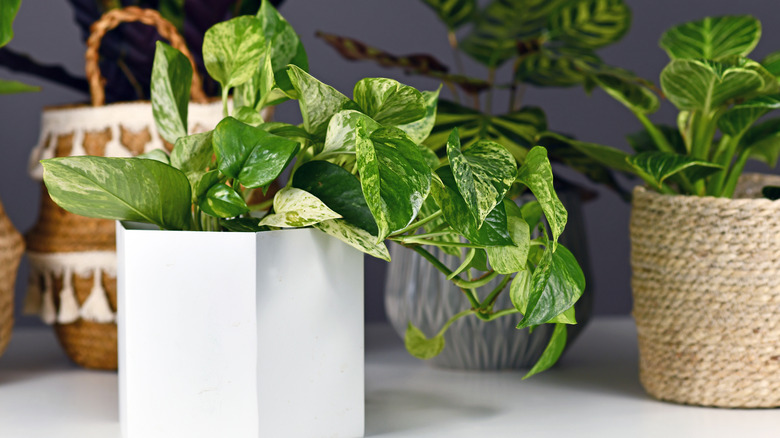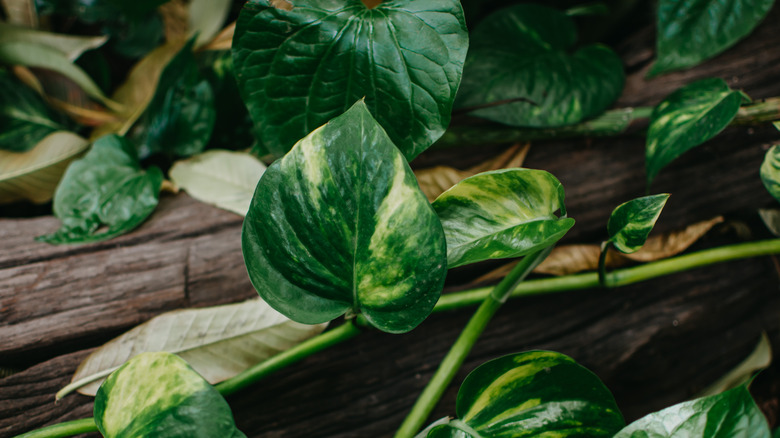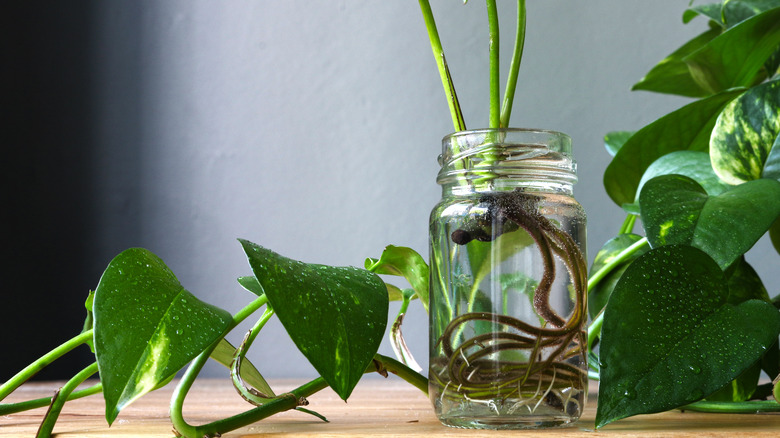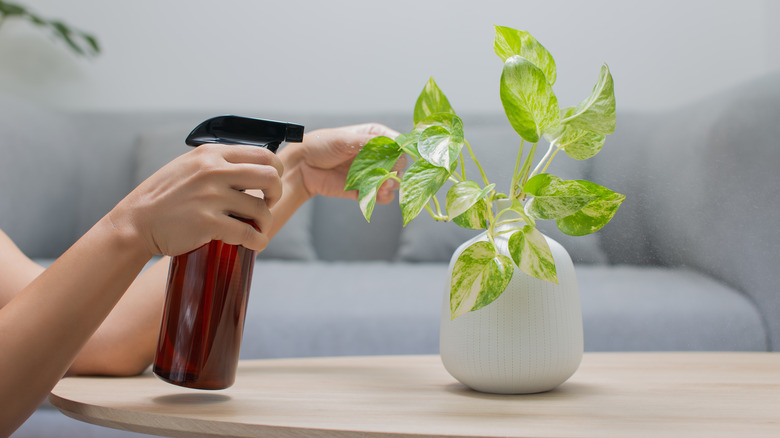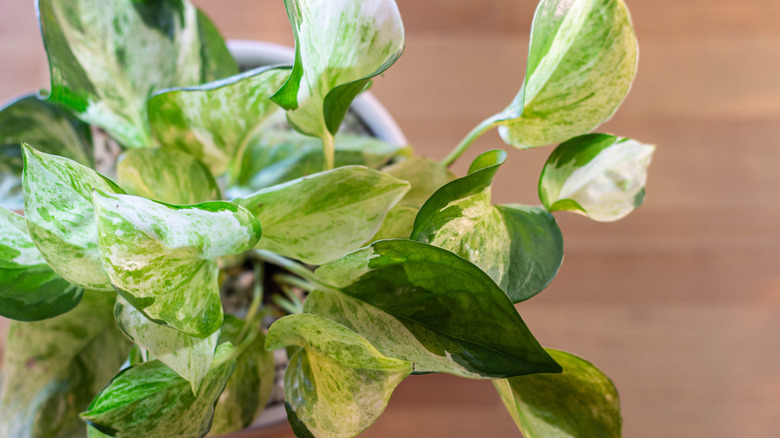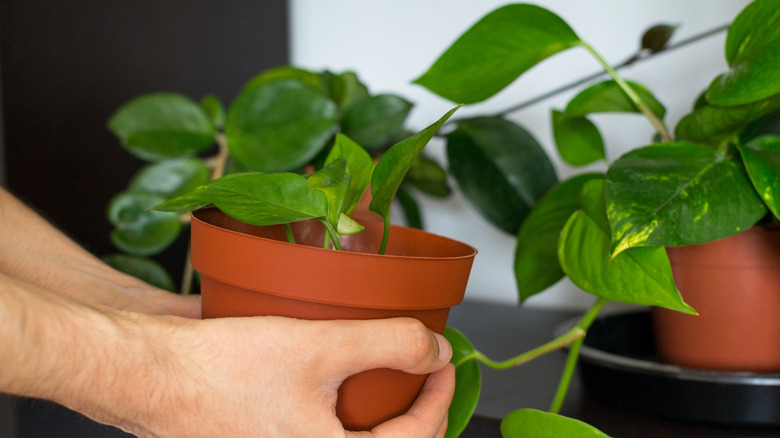How To Successfully Care For Pothos Plants
The pothos plant (Epipremnum aureum), also called golden pothos and devil's ivy, is an extremely popular houseplant. Even if you don't recognize the name, you've probably seen it countless times on friends' mantles, window sills, or in their bathrooms. According to The Spruce, it is native to the Solomon Islands. But today, you can find it growing in many tropical forests in Australia, South Africa, and the Southern parts of Asia.
Pothos plants are quite easy to care for, so if you have a habit of forgetting to tend to your plants, this one's for you. They can survive with very little water, light, and attention. This vine features bright green heart-shaped leaves often attached to several feet of trailing stems. Do not to confuse it with Philodendron, a similar-looking vine. One way to distinguish the two is by the curves of their leaves: Philodendron leaves are flat, while pothos leaves are curved inward on themselves.
How to use pothos plants in garden
Pothos can be grown in the garden, assuming you live in a place with the right conditions. It needs consistently warm weather and high humidity, says Gardening Know How, meaning USDA hardiness zones 10 through 12 are the only places you can grow thriving pothos outdoors. However, if you live on the southern tips of California, Arizona, Florida, or in the state of Hawaii, there are a few ways you can plant this vine to accent your garden.
Many people choose to plant it near the base of a tree so it may climb up it. This creates a lush green, tropical look as it covers most of the bark. Others like to plant it near a fence and train it to weave between posts. However, keep in mind that unchecked pothos can grow longer than 40 feet and take over long sections of your garden. Some gardeners do this on purpose, letting the plant grow over large soil plots as ground cover. If you prefer a neater look, regularly prune your pothos. When the vine is well taken care of, it can grow more than 1 foot every month.
How to grow pothos plants
You don't have to be an expert gardener with the greenest thumb to grow pothos. All you need is some well-draining potting soil and a self-draining pot. Pothos can be matured from a young nursery plant or the most popular method, propagation. While growing this plant from seeds is technically possible, it is very difficult to find pothos seeds. Pothos plants rarely flower, and their shy flowering habit means that getting seeds is almost impossible. According to Houseplant Stuff, even if you could get your hands on some pothos seeds, it's unlikely that the mature plant will end up being as beautiful as the source plant.
Instead, most sources recommend propagating your pothos through cuttings. You need a sterile pair of scissors and an established pothos plant to do this. Home Talk suggests starting by cutting a 4- to 6-inch length of the stem just an inch below one of the plant's leaves. Then, cut off the lowest leaf and put the stem in a glass of water with a good portion of the cut end submerged. After a few weeks, your cutting will have grown into a small but healthy root system. Now, you can repot your cutting into a container of potting soil. Leave your young pothos in indirect sunlight and keep its soil moist as it continues to grow.
How to care for pothos plants
Pothos is as easy to care for as it is to grow. Once you have potted your houseplant, you can set it anywhere in your home that works for you. Pothos prefers indirect sunlight; however, it will happily grow in part shade and even under fluorescent lights. They do not need water often because they are susceptible to root rot and similar diseases. Always allow this plant's soil to dry out completely before watering, as per Pro Flowers.
Though pothos doesn't like to be overwatered, it does enjoy humidity. Keeping a water mister handy to spray its leaves will help this plant receive the moisture it needs. Alternatively, you could consider placing it in your bathroom, kitchen, or another commonly humid area of your home. Luckily, pothos can still survive in drier environments, though it may not grow as quickly; therefore, you don't need to rush to the store to buy a humidifier. Fertilizing your pothos plant is also optional. As stated by The Spruce, they are not heavy feeders and won't mind going without plant food during their growing period. However, if you prefer, you can fertilize pothos every other month with an all-purpose liquid plant food to supplement their soil.
Pothos plants varieties
As a houseplant, pothos is chosen again and again for its many varieties, although it is a small genus with less than 20 species. Each of its species a native to the tropical forests of Southeastern Asia and have the habit of climbing trees in the wild. According to Back to the Roots, the species has a handful of varieties that feature different colors of leaves and play separate roles inside homes as cascading ornamental plants.
- "Pearls and Jade" pothos — This is a white and green variety of pothos that shows dots instead of stripes that appear as pearls, hence the name.
- "Lime" pothos — This plant has bright green-yellow leaves, similar to the color of a lime.
- "Marble Queen" pothos — This is a prevalent variety of pothos with stripes of white and green. To maintain its appearance, it must be exposed to indirect sunlight regularly.
- "Neon" pothos — This variety needs less light compared to its siblings. It features bright green leaves, which can liven up any dull area.
- "Silver Satin" pothos — This is one of the darker versions of the pothos plants with matte gray-green leaves and small blotches of silver. It is among the easiest pothos to care for since it is extremely drought tolerant.
Is pothos toxic?
Pothos can be toxic to humans, cats, and dogs. According to the ASPCA, the plant contains insoluble calcium oxalates, leading to oral irritation, drooling, trouble swallowing, and vomiting if ingested. Therefore, you should never have this plant within reach of small children or pets. If you suspect that they have gotten their hands on some pothos leaves, immediately call the poison control center to learn what to do next.
Pothos' toxicity has various levels. Garden and Sunshine explains that small nibbles of a pothos leaf may have no effect, whereas ingesting large amounts can be life-threatening. The plant's leaves have a bitter taste which can help keep pets and children away after their first taste, but you should avoid letting them ever get that close. The best recommendation for keeping small lives safe from pothos is not having it in your home; there are several similar plants you can choose to grow instead. Yet, if you are set on nurturing this plant, make sure it is high off the ground, on a shelf they can not reach. Pin up the vines, so they grow up towards the ceiling instead of down towards the floor. For extra protection, consider spraying a vinegar mixture on the pothos leaves to discourage chewing on them even further.
How to repot pothos plants
If your pothos plant stops growing or its leaves begin to droop, it's likely pot-bound. This means that its roots have grown so extensively in its pot that they have nowhere to go. To avoid this, you should repot your pothos once every year during the spring or summer. The Spruce recommends checking if your plant has become pot-bound by carefully taking it out of its pot. If its roots are very visible outside the soil, your plant is pot-bound. Your pothos should have at least 2 inches of soil between its root ball and its pot.
To repot this plant, you will need a self-draining container that is at least two sizes bigger than the last. You will also need well-draining soil. You can repot your pothos the same way that you would transplant any other ordinary perennial plant. Start by gently removing the entire plant from its previous pot and teasing the old soil from its roots. Then, transfer it to the new container with new soil, packing the potting mix on top of the roots. Finally, water your pothos until it runs into the saucer. Make sure to throw out any excess water to combat root rot.
